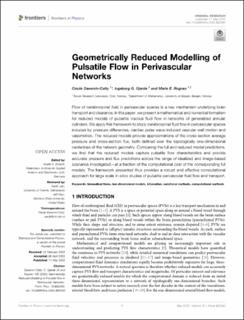Geometrically Reduced Modelling of Pulsatile Flow in Perivascular Networks
Journal article, Peer reviewed
Published version

Åpne
Permanent lenke
https://hdl.handle.net/11250/3060157Utgivelsesdato
2022Metadata
Vis full innførselSamlinger
- Department of Mathematics [939]
- Registrations from Cristin [9791]
Sammendrag
Flow of cerebrospinal fluid in perivascular spaces is a key mechanism underlying brain transport and clearance. In this paper, we present a mathematical and numerical formalism for reduced models of pulsatile viscous fluid flow in networks of generalized annular cylinders. We apply this framework to study cerebrospinal fluid flow in perivascular spaces induced by pressure differences, cardiac pulse wave-induced vascular wall motion and vasomotion. The reduced models provide approximations of the cross-section average pressure and cross-section flux, both defined over the topologically one-dimensional centerlines of the network geometry. Comparing the full and reduced model predictions, we find that the reduced models capture pulsatile flow characteristics and provide accurate pressure and flux predictions across the range of idealized and image-based scenarios investigated—at a fraction of the computational cost of the corresponding full models. The framework presented thus provides a robust and effective computational approach for large scale in-silico studies of pulsatile perivascular fluid flow and transport.
